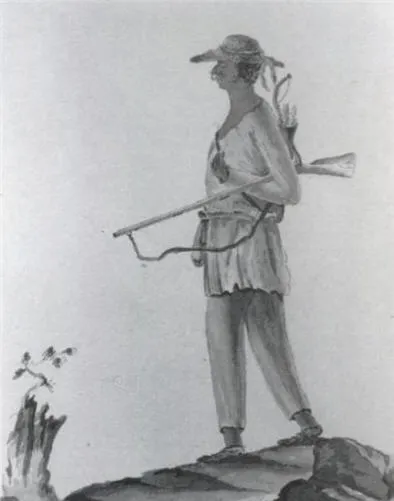
A mission house, built about 1740 in Stockbridge, Massachusetts; postcard c. 1908.
As news spread across Massachusetts about the British expedition to Concord and the shots fired on April 19, 1775, organized militia units marched toward Boston, the British stronghold. Among the units that arrived was the Stockbridge Company comprised of Native Americans who decided to side with the rebel colonists. This unit had an interesting and complicated history in the early days of the Revolutionary War and beyond.
The Muh-he-con-neok (Muhheakun’nuk) people of the Mahican, Housatonic, Wappinger, Tunxis and Shawnee tribes populated the town of Stockbridge in western Massachusetts. The town had been established as a “Praying Town” by Indigenous People who had converted to Christianity and lived between Native traditions and settler colonialism. During conflicts in the early 18th Century, the people of Stockbridge had sided with the British colonies and had a long-standing tradition of forming a militia unit and fighting alongside white colonial militia companies.
Following the end of the French & Indian War in 1763, white settlers encroached on Mohican land and in Stockbridge began changing local civics and pushing out the tribal leadership. The Stockbridge-Mohicans appealed through British colonial government and even petitioned the British government in London, but their requests went unanswered. Conflicted and disillusioned, the Stockbridge-Mohicans observed the Massachusetts protests against taxation and lack of representation in Parliament. The Stockbridge residents eventually took part in the boycotts of British goods and voiced support of the colonial oppositions. This placed the community alongside white colonists in common cause, and the Stockbridge leaders hoped this would be best way to protect their land and sovereignty and appealed to Massachusetts state government and the Continental Congresses for that purpose.
In 1774 as communities across Massachusetts organized or strengthened their militia companies, the Native American leaders at Stockbridge gathered and committed to forming a militia unit, too. They promised their Massachusetts neighbors: “Wherever your armies go, there we will go; you shall always find us by your side; and if providence calls us to sacrifice our Lives in the field of battle, we will fall where you fall, and lay our bones by yours. Nor shall peace ever be made between our nation and the Red-Coats until our brothers—the white people—lead the way.” Massachusetts delegates responded to the commitment saying, “Your engaging in this cause discovers not only your attachment to your liberties, but furnishes us with an evidence of your gratitude[,] … abundant proof of your fidelity[,] … and [we] shall depend upon your firm and steady attachment to the cause you have engaged in.”
According to some traditions, members of the Stockbridge Company fired shots on April 19, 1775, during the fighting along Battle Road as the British troops retreated from Concord. Some researchers suggest it is possible there were individual members of the unit present at the battle, but the best reference to the arrival of the organized group known as the “Stockbridge Indian Company” are in the early weeks of the Siege of Boston where they frequently ambushed British soldiers and outposts. The company also fought during the Battle of Bunker Hill on June 17, 1775.
The following year—1776—General George Washington commanding the Continental Army sought to recruit more Stockbridge-Mohicans to serve with American forces. They often served as scouts and acted as ambassadors to other Native American tribes during the Revolutionary War.

The Stockbridge warriors fought in upstate New York defending Fort Ticonderoga, working with American General Benedict Arnold and requested to joined General Horatio Gates during the Saratoga Campaign. After the British surrender at Saratoga in 1777, the Stockbridge Company joined Washington’s army at Valley Forge, fought at the Battle of Monmouth and joined Sullivan’s Expedition against the Iroquois Confederacy. Fighting at Kingsbridge near White Plains, New York, in 1778 resulted in the company entangling in a fierce skirmish with Tarleton’s dragoons, Hessian soldiers and Loyalist militia. Outnumbered, the Stockbridge Company was overwhelmed and many of the community’s leaders died.
At home in Stockbridge, the Native American residents were harassed and continually struggled to keep possession of their land. The civilians appealed to the Continental Congress for help, especially for the widows and orphans in the community whose husbands and fathers had died in the war. The appeals included reminders that many of the Stockbridge men had volunteered and were serving alongside the Continental Army. However, by 1783 and the ending the American Revolution, the Mohican-owned land at Stockbridge had been overtaken. Forced out of Massachusetts, the Mohican community moved further west. They fought in the Revolution but were not protected or recognized for their sacrifices in the years immediately following.
Eventually, the residents and descendants of Stockbridge settled in modern-day Wisconsin. Now, the Stockbridge-Munsee Community (Band) of Mohican Indians is located in Shawano County, Wisconsin. The seal of the Stockbridge-Munsee nation was created to symbolize “endurance, strength and hope” — reflecting the solemn history of survival.
Further Reading:
- History of the Stockbridge-Munsee Community Band of Mohican Indians, "Brief History."
- Journal of the American Revolution, “The Stockbridge-Mohican Community, 1775-1783.”





